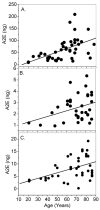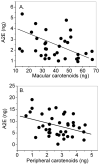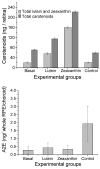Retinal carotenoids can attenuate formation of A2E in the retinal pigment epithelium
- PMID: 18926795
- PMCID: PMC2683766
- DOI: 10.1016/j.abb.2008.09.012
Retinal carotenoids can attenuate formation of A2E in the retinal pigment epithelium
Erratum in
- Arch Biochem Biophys. 2010 Jan 15;493(2):252
Abstract
A2E, an important constituent of lipofuscin in human retinal pigment epithelium (RPE), is thought to mediate light-induced oxidative damage associated with aging and other ocular disorders. Ocular carotenoids in overlying retinal tissues were measured by HPLC and mass spectrometry and were correlated with levels of RPE A2E. We observed a statistically significant increase in total A2E levels in human RPE/choroid with age, and A2E levels in macular regions were approximately 1/3 lower than in peripheral retinal regions of the same size. There was a statistically significant inverse correlation between peripheral retina carotenoids and peripheral RPE/choroid A2E. Prospective carotenoid supplementation studies in Japanese quail demonstrated nearly complete inhibition of A2E formation and oxidation. These findings support current recommendations to increase dietary intake of xanthophyll carotenoids in individuals at risk for macular degeneration and highlight a new potential mechanism for their protective effects-inhibition of A2E formation and oxidation in the eye.
Figures





References
-
- Rattner A, Nathans J. Nat Rev Neurosci. 2006;7:860–872. - PubMed
-
- Beatty S, Koh H, Phil M, Henson D, Boulton M. Surv Ophthalmol. 2000;45:115–134. - PubMed
-
- Dorey CK, Wu G, Ebenstein D, Garsd A, Weiter JJ. Invest Ophthalmol Vis Sci. 1989;30:1691–1699. - PubMed
-
- Lamb LE, Simon JD. Photochem and Photobiol. 2004;79:127–136. - PubMed
Publication types
MeSH terms
Substances
Grants and funding
LinkOut - more resources
Full Text Sources
Other Literature Sources

